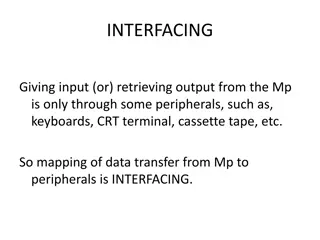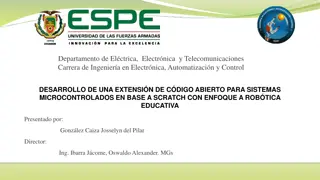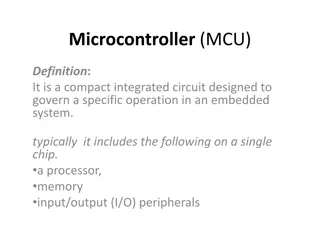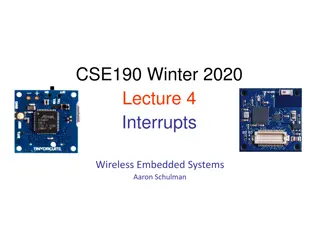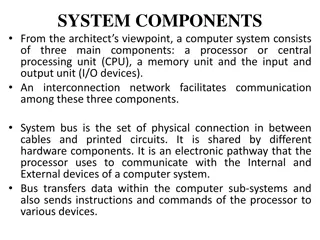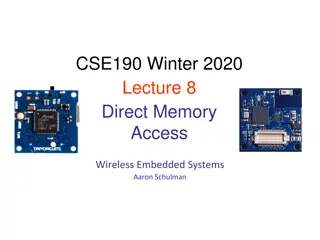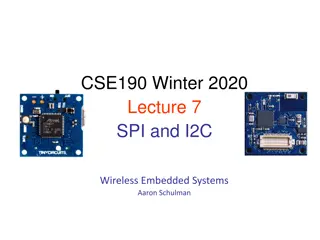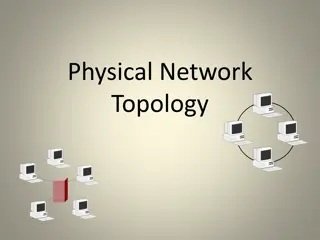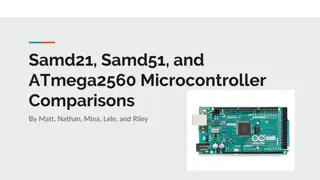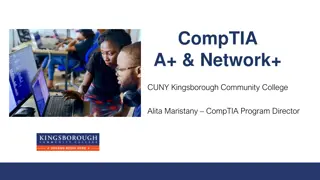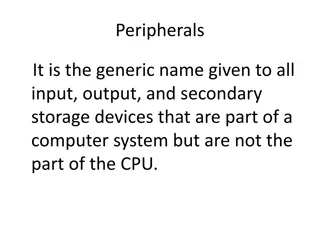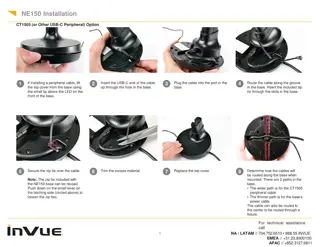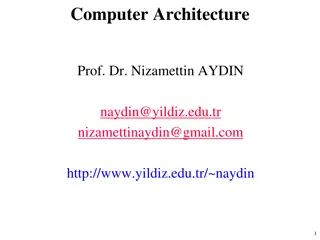EMPLOYABILITY SKILLS. INFORMATION & COMMUNICATION TECHNOLOGY SKILLS
ICT skills are crucial for modern life, enabling individuals to communicate, access information, and use technology effectively. This article explores the importance of ICT skills in the workplace and at home, covering tools like smartphones, tablets, TV, radio, and applications. It also delves into
0 views • 23 slides
Computer Peripherals and Interfacing
Computer peripherals are external devices that enhance the functionality of a computer. They include input devices like keyboards and mice, output devices like printers and monitors, and storage devices like hard disk drives and solid-state drives. Interfacing circuits connect these peripherals to t
1 views • 6 slides
Understanding Data Transfer and Interfacing in Computer Systems
Data transfer in computer systems involves interfacing between the central processing unit (CPU) and various peripherals such as keyboards, CRT terminals, and cassette tapes. This process enables the exchange of information between internal storage and external input/output (I/O) devices. Interface
6 views • 70 slides
Development of Open Source Extension for Microcontrolled Systems with Scratch Approach in Educational Robotics
In the era of technological advancements, integrating programming concepts into educational contexts is crucial. This project focuses on developing an open-source code extension for microcontrolled systems using Scratch, emphasizing educational robotics. It aims to establish communication between mi
6 views • 34 slides
Understanding Microcontrollers: Definition, Working, and Elements
A microcontroller (MCU) is a compact integrated circuit essential for embedded systems, controlling specific operations. This article delves into the definition, functioning, and key elements of microcontrollers, such as the processor, memory, and I/O peripherals. Explore how microcontrollers work,
0 views • 16 slides
Understanding Interrupts in Embedded Systems
In embedded systems, interrupts play a crucial role in letting peripherals notify the CPU of state changes. They are events external to the current process that disrupt the normal flow of instruction execution, typically generated by hardware devices. By using interrupts, CPUs can efficiently handle
1 views • 12 slides
Understanding Computer System Buses: Components and Functions
A computer system comprises three main components - the CPU, memory unit, and I/O devices connected via an interconnection network, facilitated by the system bus. System buses reduce communication pathways, enabling high-speed data transfer and synchronization between components. Internal buses conn
3 views • 55 slides
Understanding Direct Memory Access (DMA) in Embedded Systems
Direct Memory Access (DMA) plays a crucial role in transferring large blocks of data efficiently in embedded systems. This technology allows data to be moved between peripherals and main memory without continuous processor intervention, enhancing speed and reducing CPU overhead. By offloading data t
1 views • 16 slides
Comparison of SPI and I2C Communication in Embedded Systems
SPI and I2C are two common communication protocols used in embedded systems. SPI offers fast and easy point-to-point connections with no addressing needed, while I2C allows connecting multiple peripherals with just two wires. SPI has pros such as fast data transfer but cons like complexity with mult
1 views • 17 slides
Understanding Physical Network Topologies
Physical network topology refers to the layout of cables, computers, and peripherals in a network, distinct from logical topology. Common physical topologies include Star, Ring, Linear Bus, Tree, and Mesh. Each topology has its advantages and disadvantages, impacting network performance and reliabil
0 views • 16 slides
Understanding Microcontrollers: A Comprehensive Overview
Microcontrollers, like the Samd21, Samd51, and ATmega2560, are essential components in electronic systems, featuring processors, memory units, and peripherals. Learn about their history, applications in automobiles and medical devices, as well as how they work and their structure. Explore the role o
5 views • 14 slides
CompTIA Program at CUNY Kingsborough Community College
The CompTIA Program at CUNY Kingsborough Community College is a free online training program funded by the U.S. Department of Labor. It aims to prepare students for the CompTIA certification exam and train them to become Computer Support Technicians. The program offers internship opportunities and e
0 views • 10 slides
Overview of Computer Peripherals and Input Technology
Computer peripherals encompass various input and output devices integral to a computer system beyond the CPU. This includes pointing devices like mice, styluses, trackballs, touchpads, touchscreens, light pens, and speech recognition systems. These technologies enhance user interaction, offering mor
0 views • 13 slides
Solar Energy Generator Design Rendering and Prototype Details
Solar Energy Generator design includes a prototype system mounted in a Pelican case with various peripherals. The system features a Laser Cut Delrin Panel covering all electronics with display, buttons, and a rotary encoder. External connections are facilitated through Souriau UTS circular connector
0 views • 7 slides
NE150 Installation Guide for USB-C Peripherals
Learn how to install USB-C peripherals such as the CT1505, route cables, mount the base using adhesive or non-slip pads, and securely attach a tablet with detailed step-by-step instructions and illustrations.
0 views • 8 slides
Understanding Computer Architecture and Input/Output Systems
Explore the world of computer architecture, input/output systems, external devices, I/O modules, and the challenges of I/O processing. Learn about the functions, structures, and interfaces involved in handling data transfer between CPU, memory, and peripherals. Discover the evolution of I/O function
1 views • 65 slides
Understanding System on Chip (SoC) Design and Components
Explore the world of System on Chip (SoC) design, components, and working flow. Learn about Intellectual Properties (IP), platform-based design, typical design flows, top-down design approach, and the emerging Electronic System Level (ESL) design flow. Discover the essential components of an SoC, su
0 views • 45 slides
Understanding User and Group Permissions in Linux Systems
Linux uses user and group permissions to control access to files, directories, and peripherals. Users are managed for security purposes by limiting access, with the root user having full system access. Grouping users into groups with specific access grants can enhance security. Each file is owned by
0 views • 23 slides
Wireless Office Docking Model for Multiple Devices
This document outlines a usage model for office docking involving wireless connections between mobile devices and various peripheral devices such as monitors, hard drives, printers, and more. It describes scenarios for single and multiple devices in both home and office settings, emphasizing the nee
0 views • 5 slides
Understanding Timers and Time Tracking in Embedded Systems
Explore the importance of timers in embedded systems for tracking time, managing interrupts, and ensuring accurate timekeeping. Learn about different peripherals used, such as real-time clocks and processor timers, to handle tasks like updating UI elements, triggering alarms, and measuring intervals
0 views • 24 slides
Maximize Your Connectivity with Cadyce's Versatile Port Hub
Unlock the full potential of your devices with Cadyce's innovative port hub. This essential accessory expands your connectivity options, allowing you to connect multiple peripherals effortlessly. Whether you need to link a keyboard, mouse, external d
4 views • 5 slides
FPGA for Underwater Communication Project Overview
This project, led by Pradyumna (Prad) Kadambi with mentor Cody Youngbull, aims to develop a robust high-speed underwater communication system using Field Programmable Gate Arrays (FPGA). The project addresses the slow and cumbersome nature of current underwater communication methods, with a focus on
0 views • 9 slides


